LNMP
LNMP简介
LNMP代表的就是:Linux系统下Nginx+MySQL+PHP这种网站服务器架构。
GNU / Linux 操作系统:
Linux是一种类似Unix的计算机操作系统,Linux操作系统有很多个不同的发行版,如Red Hat 、SUSE 、FreeBSD、Debian、CentOS等。
Nginx服务器:
Nginx是一个小巧而高效的Linux下的Web服务器软件和反向代理服务器,也是一个IMAP/POP3/SMTP代理服务器。是由 Igor Sysoev 为俄罗斯访问量第二的 Rambler 站点开发的,已经在一些俄罗斯的大型网站上运行多年,相当的稳定。Nginx性能稳定、功能丰富、运维简单、处理静态文件速度快且消耗系统资源极少。
MySQL 类关系型数据库(RDBMS):是一个小型关系型数据库管理系统。
php编程语言:服务器端执行的嵌入HTML文档的脚本语言。
LNMP架构原理
客户端发送http request请求 ,服务器(Nginx)接受web请求;
Nginx判断客户端请求的资源是否为。若是静态请求,则Nginx直接将客户端请求的静态资源(.html, .htm .shtml等文件),通过Http response的形式传送给客户端;
若为php动态请求,则php脚本通过接口传输协议(网关协议)PHP-FCGI(fast-cgi)传输给PHP-FPM(进程管理程序)序,PHP-FPM不做处理,然后PHP-FPM调用PHP解析器进程,PHP解析器解析php脚本信息。
PHP在执行php请求时判断是否会依赖mysql数据库。若不依赖mysql数据库,则PHP-FPM不做处理,然后PHP-FPM调用PHP解析器进程,服务器再通过Http response的形式传送给浏览器,浏览器再进行解析与渲染然后进行呈现。
若依赖mysql数据库,则php程序通过php-mysql 驱动与mysql进行关联 ,获取相关数据 ,然后将其返还给php解释器 ,再次执行不依赖mysql数据库的流程。
Fast-CGI 介绍
cgi是通用网关接口,是外部应用程序与Web服务器之间的接口标准,cgi是为了保证web server传递过来的数据是标准格式的,方便cgi程序的编写者。
Fast-cgi像是一个常驻(long-live)型的cgi,是用来提高cgi程序性能的。
fast-CGI是nginx和php之间的一个通信接口,该接口实际处理过程通过启动php-fpm进程来解析php脚本,即php-fpm相当于一个动态应用服务器,从而实现nginx动态解析php。因此,如果nginx服务器需要支持php解析,需要在nginx.conf中增加php的配置;将php脚本转发到fastCGI进程监听的IP地址和端口(php-fpm.conf中指定)。同时,php安装的时候,需要开启支持fastCGI选项,并且编译安装php-fpm补丁/扩展,同时,需要启动php-fpm进程,才可以解析nginx通过fastCGI转发过来的php脚本。
Fast-CGI的工作原理
Web Server启动时载入Fast-CGI进程管理器(IIS ISAPI或PHP-FPM)
FastCGI进程管理器自身初始化,启动多个CGI解释器进程(可见多个php-cgi)并等待来自Web Server的连接。
当客户端请求到达Web Server时,Fast-CGI进程管理器选择并连接到一个CGI解释器。Web server将CGI环境变量和标准输入发送到Fast-CGI子进程php-cgi。
Fast-CGI子进程完成处理后将标准输出和错误信息从同一连接返回Web Server。当Fast-CGI子进程关闭连接时,请求便告处理完成。Fast-CGI子进程接着等待并处理来自Fast-CGI进程管理器(运行在Web Server中)的下一个连接。 在CGI模式中,php-cgi在此便退出了。
LNMP编译安装(应用于nginx与fastcgi安装在同一台的情况)
参考:https://www.logmm.org/lnmp_the_same_pc/ lnmp编译安装【同一机子上】
LNMP部署环境:
-
系统:Centos 6.6
-
软件:nginx-1.8.1+ mysql-5.5.61 + php-5.6.38
编译环境:安装LNMP相关依赖环境,包括"Server PlatForm Development" "Development tools",关闭selinux 和 iptables 功能,并配置epel yum源
实验目的:编译安装LAMP,通过php-fpm实现php与nginx链接 。
**一、配置编译环境 **
[root@test-6 ~]# yum groupinstall "Development tools" -y # 安装包组开发工具
[root@test-6 ~]# yum groupinstall "Server Platform Development" -y # 安装包组服务开发环境
[root@test-6 ~]# yum -y install gcc gcc-c++ autoconf pcre pcre-devel openssl openssl-devel zlib zlib-devel make automake
[root@test-6 ~]# vim /etc/selinux/config # 修改配置文件,关闭selinux功能
SELINUX=disabled # 设定为disabled
#SELINUXTYPE=targeted # 注释该项,行首添加#
[root@ test-6 ~]# getenforce # 验证selinux功能是否关闭
Disabled
[root@test-6 ~]# chkconfig iptables off # 禁止开机自启动iptables功能
[root@test-6 ~]# service iptables stop # 停止iptables 功能
[root@test-6 ~]# vim /etc/yum.repos.d/CentOS-Base.repo # 配置epel源,添加如下内容
[epel]
name=CentOS-$releasever-Epel
baseurl=https://mirrors.aliyun.com/epel/6Server/x86_64/
gpgcheck=1
enabled=1
gpgkey=https://mirrors.aliyun.com/epel/RPM-GPG-KEY-EPEL-6Server
[root@test-6 ~]# yum clean all # 清理yum缓存
Loaded plugins: fastestmirror, security
Cleaning repos: base epel extras updates
Cleaning up Everything
Cleaning up list of fastest mirrors
[root@test-6 ~]# yum repolist # 查看yum源报告
二、编译安装Nginx(nginx-1.8)
- 编译安装pcre(pcre-8.37)
PCRE是一个Perl库,中文"Perl兼容的正则表达式库"。安装Nginx是为了使Nginx支持具备URI重写功能的rewrite模块,如果不安装pcre库,则Nginx无法使用rewrite模块功能,Nginx的Rewrite模块功能几乎是企业应用必须;
下载地址:https://ftp.pcre.org/pub/pcre/pcre-8.37.tar.bz2
[root@test-6 nginx]# tar xf pcre-8.37.tar.gz
[root@test-6 nginx]# cd pcre-8.37
[root@test-6 pcre-8.37]# ./configure --prefix=/usr/local/pcre
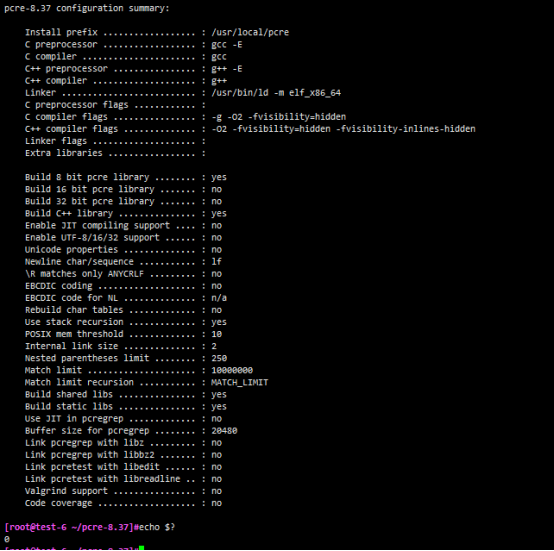
[root@test-6 pcre-8.37]# make && make install
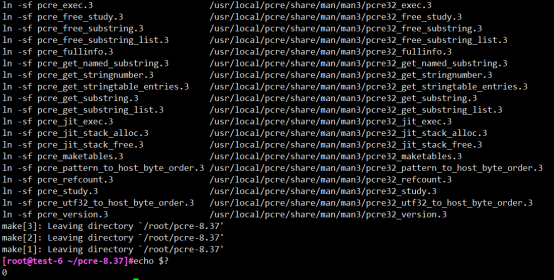
- 编译安装zlib(zlib-1.2.11.tar.gz)
zlib 库提供了很多种压缩和解压缩的方式, nginx 使用 zlib 对 http 包的内容进行 gzip
下载地址: http://prdownloads.sourceforge.net/libpng/zlib-1.2.11.tar.gz?download
[root@test-6 nginx]# tar -xf zlib-1.2.11.tar.gz
[root@test-6 nginx]# cd zlib-1.2.11
[root@test-6 zlib-1.2.11]# ./configure --prefix=/usr/local/zlib
[root@test-6 zlib-1.2.11]# make && make install
- 编译安装openssl(openssl-1.0.2p.tar.gz)
OpenSSL 是一个强大的安全套接字层密码库,囊括主要的密码算法、常用的密钥和证书封装管理功能及 SSL 协议,并提供丰富的应用程序供测试或其它目的使用。 nginx 不仅支持 http 协议,还支持 https(即在ssl协议上传输http)。
下载地址:https://www.openssl.org/source/openssl-1.0.2p.tar.gz
[root@test-6 nginx]# tar -xf openssl-1.0.2o.tar.gz
[root@test-6 nginx]# cd openssl-1.0.2o
[root@test-6 openssl-1.0.2o]# ./config --prefix=/usr/local/openssl
[root@test-6 openssl-1.0.2o]# make && make install
- 编译安装nginx
下载地址:https://nginx.org/download/nginx-1.8.1.tar.gz
[root@test-6 nginx]# groupadd -r www
[root@test-6 nginx]# useradd -g www -s /sbin/nologin -r -M www # 添加www用户
[root@test-6 nginx]# tar -xf nginx-1.8.1.tar.gz
[root@test-6 nginx]# cd nginx-1.8.1
[root@test-6 nginx-1.8.1]# ./configure \
--user=www \
--group=www \
--prefix=/usr/local/nginx \
--with-http_sub_module \
--with-http_stub_status_module \
--with-http_gzip_static_module \
--with-http_ssl_module \
--with-pcre=/usr/local/src/nginx/pcre-8.37 \
--with-zlib=/usr/local/src/nginx/zlib-1.2.11 \
--with-openssl=/usr/local/src/nginx/openssl-1.0.2o
注意:如果没有源码安装依赖包的就用这组参数:
./configure \
--user=www \
--group=www \
--prefix=/usr/local/nginx \
--conf-path=/etc/nginx/nginx.conf \
--sbin-path=/usr/sbin/nginx \
--with-http_sub_module \
--with-http_stub_status_module \
--with-http_gzip_static_module \
--with-http_ssl_module \
--with-pcre
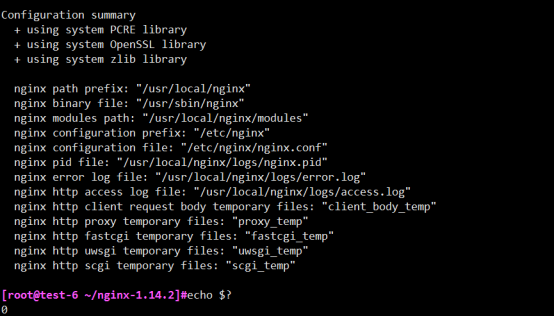
[root@test-6 nginx-1.8.1]# make && make install
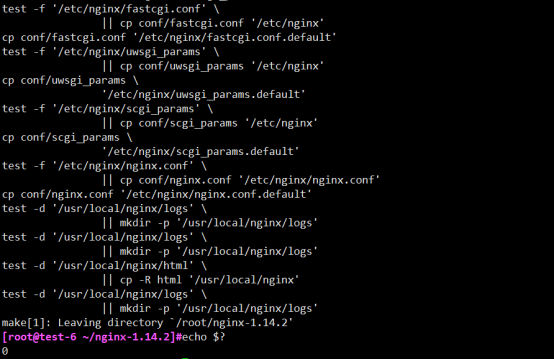
到此,如果没有报错,nginx就可以正常运行了
[root@test-6 nginx-1.8.1]# cd /usr/local/nginx/
[root@test-6 nginx]# ls
conf html logs sbin
[root@test-6 nginx]# vi /etc/profile.d/nginx.sh # 配置环境变量
export PATH=/usr/local/nginx/sbin:$PATH
[root@test-6 conf]# ln -sv /usr/local/nginx/conf /etc/nginx # 链接nginx配置文件
`/etc/nginx' -> `/usr/local/nginx/conf/'
[root@test-6 nginx-1.8.1]# mkdir /var/run/nginx # 创建 nginx pid 文件目录
[root@test-6 nginx-1.8.1]# chown www.www /var/run/nginx # 配置/var/run/nginx 文件属性
[root@test-6 conf]# vi /etc/nginx/nginx.conf # 调整nginx配置文件
user www www; # Nginx运行使用的用户为www
pid /var/run/nginx/nginx.pid; # 配置nginx.pid文件路径
[root@test-6 run]# nginx -t -c /etc/nginx/nginx.conf # 确认配置文件格式及语法是否正确
nginx: the configuration file /etc/nginx/nginx.conf syntax is ok
nginx: configuration file /etc/nginx/nginx.conf test is successful
- 设置nginx服务启动脚本,启动Nginx服务并进行验证
[root@test-6 conf]# scp root@192.168.23.100:/etc/rc.d/init.d/nginx /etc/init.d/
# 从其他yum 安装nginx的服务器拷贝nginx 服务启动脚本到/etc/init.d 目录中
Nginx wiki网站已经有这个脚本(CentOS)http://wiki.nginx.org/RedHatNginxInitScript,稍做修改即可以用,在lnmp脚本已经运用
#!/bin/sh
#
# nginx - this script starts and stops the nginx daemon
#
# chkconfig: - 85 15
# description: NGINX is an HTTP(S) server, HTTP(S) reverse \
# proxy and IMAP/POP3 proxy server
# processname: nginx
# config: /etc/nginx/nginx.conf
# config: /etc/sysconfig/nginx
# pidfile: /var/run/nginx.pid
# Source function library.
. /etc/rc.d/init.d/functions
# Source networking configuration.
. /etc/sysconfig/network
# Check that networking is up.
[ "$NETWORKING" = "no" ] && exit 0
nginx="/usr/sbin/nginx"
prog=$(basename $nginx)
NGINX_CONF_FILE="/etc/nginx/nginx.conf"
[ -f /etc/sysconfig/nginx ] && . /etc/sysconfig/nginx
lockfile=/var/lock/subsys/nginx
make_dirs() {
# make required directories
user=`$nginx -V 2>&1 | grep "configure arguments:.*--user=" | sed 's/[^*]*--user=\([^ ]*\).*/\1/g' -`
if [ -n "$user" ]; then
if [ -z "`grep $user /etc/passwd`" ]; then
useradd -M -s /bin/nologin $user
fi
options=`$nginx -V 2>&1 | grep 'configure arguments:'`
for opt in $options; do
if [ `echo $opt | grep '.*-temp-path'` ]; then
value=`echo $opt | cut -d "=" -f 2`
if [ ! -d "$value" ]; then
# echo "creating" $value
mkdir -p $value && chown -R $user $value
fi
fi
done
fi
}
start() {
[ -x $nginx ] || exit 5
[ -f $NGINX_CONF_FILE ] || exit 6
make_dirs
echo -n $"Starting $prog: "
daemon $nginx -c $NGINX_CONF_FILE
retval=$?
echo
[ $retval -eq 0 ] && touch $lockfile
return $retval
}
stop() {
echo -n $"Stopping $prog: "
killproc $prog -QUIT
retval=$?
echo
[ $retval -eq 0 ] && rm -f $lockfile
return $retval
}
restart() {
configtest || return $?
stop
sleep 1
start
}
reload() {
configtest || return $?
echo -n $"Reloading $prog: "
killproc $nginx -HUP
RETVAL=$?
echo
}
force_reload() {
restart
}
configtest() {
$nginx -t -c $NGINX_CONF_FILE
}
rh_status() {
status $prog
}
rh_status_q() {
rh_status >/dev/null 2>&1
}
case "$1" in
start)
rh_status_q && exit 0
$1
;;
stop)
rh_status_q || exit 0
$1
;;
restart|configtest)
$1
;;
reload)
rh_status_q || exit 7
$1
;;
force-reload)
force_reload
;;
status)
rh_status
;;
condrestart|try-restart)
rh_status_q || exit 0
;;
*)
echo $"Usage: $0 {start|stop|status|restart|condrestart|try-restart|reload|force-reload|configtest}"
exit 2
esac
[root@test-6 conf]# vi /etc/init.d/nginx # 修改nginx服务启动脚本
...
nginx="/usr/local/nginx/bin/nginx" # 指定nginx命令路径
lockfile="/var/lock/nginx" # 指定nginx lockfile文件
pidfile="/var/run/nginx/${prog}.pid" # 指定nginx 启动pid文件路径
NGINX_CONF_FILE="/etc/nginx/nginx.conf" # 指定配置脚本nginx.conf 文件路径
[root@test-6 nginx]# chkconfig --add nginx # 设置添加到chkconfig 列表
[root@test-6 nginx]# chkconfig nginx on # 设置开机自动启动
[root@test-6 nginx]# service nginx start # nginx服务启动
Starting nginx: [ OK ]
[root@test-6 nginx]# ss -tunlp | grep nginx
tcp LISTEN 0 128 *:80 *:* users:(("nginx",11893,6),("nginx",11895,6))
[root@test-6 nginx]# ps aux | grep nginx # 验证nginx服务 ,root角色启动主进程 ,www角色启动worker proess进程
root 11893 0.0 0.0 17996 836 ? Ss 13:32 0:00 nginx: master process /usr/local/nginx/sbin/nginx -c /etc/nginx/nginx.conf
www 11895 0.0 0.0 18448 1812 ? S 13:32 0:00 nginx: worker process
root 11915 0.0 0.0 103328 848 pts/0 S+ 13:33 0:00 grep nginx
[root@test-6 nginx]# curl -I http://localhost # 验证nginx 运行状态
HTTP/1.1 200 OK
Server: nginx/1.8.1
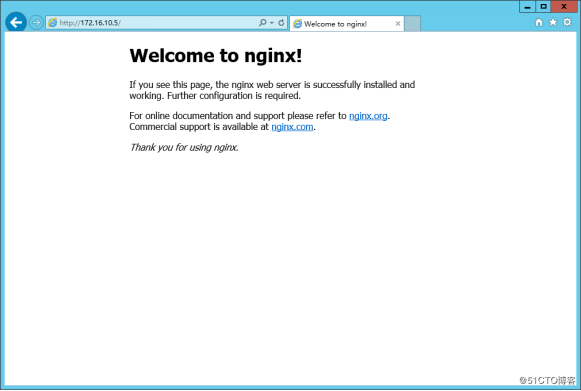
三、编译安装Mysql(mysql-5.5.61)
- 建议在硬
raid中创建lvm并使用独立的lvm磁盘作为mysql 数据存储目录 ,便于备份mysql数据
[root@test-6 ~]# pvs # 查看磁盘剩余空间
PV VG Fmt Attr PSize PFree
/dev/sda2 vg0 lvm2 a--u 439.45g 92.77g
[root@test-6 ~]# vgs # 查看磁盘剩余空间
VG #PV #LV #SN Attr VSize VFree
vg0 1 6 0 wz--n- 439.45g 92.77g
[root@test-6 ~]# lvcreate -n data -L 50G vg0 # 创建lvm分区data ,大小为50G
Logical volume "data" created.
[root@test-6 ~]# lvs # 查看创建的lvm分区
LV VG Attr LSize Pool Origin Data% Meta% Move Log Cpy%Sync Convert
data vg0 -wi-a----- 50.00g
[root@test-6 ~]# mke2fs -t ext4 /dev/mapper/vg0-data # 格式化分区/dev/sda4
mke2fs 1.41.12 (17-May-2010)
Filesystem label=
OS type: Linux
Writing inode tables: done
Creating journal (32768 blocks): done
Writing superblocks and filesystem accounting information: done
This filesystem will be automatically checked every 34 mounts or
180 days, whichever comes first. Use tune2fs -c or -i to override.
[root@test-6 ~]# mount /dev/mapper/vg0-data /data/
[root@test-6 ~]# mkdir /data # 创建目录,做挂载目录用途
[root@VM ~]# vi /etc/fstab # 配置开机自动挂载/dev/mapper/vg0-data 分区
/dev/mapper/vg0-data /data ext4 defaults 1 2
[root@VM ~]# mount -a # 挂载所有分区
[root@test-6 ~]# mount | grep data # 查看验证lvm分区挂载
/dev/mapper/vg0-data on /data type ext4 (rw)
- 编译安装mysql
下载地址:https://mirrors.163.com/mysql/Downloads/MySQL-5.5/mysql-5.5.61.tar.gz
[root@test-6 mysql]# groupadd mysql -r # 添加mysql组
[root@test-6 mysql]# useradd -s /sbin/nologin -g mysql mysql # 添加系统用户mysql
[root@test-6 mysql]# id mysql # 查看mysql用户
uid=498(mysql) gid=498(mysql) groups=498(mysql)
[root@test-6 mysql]# mkdir /data/sqldata /var/run/mysql /var/lock/mysql # 创建mysql数据的目录/data/sqldata,pid目录/var/run/mysql ,lock目录/var/lock/mysql
[root@test-6 mysql]# chown mysql.mysql /var/run/mysql/ /var/lock/mysql/ /data/sqldata/ # 必须调整目录权限属主、属组为mysql,这样才有写的权限
[root@test-6 mysql]# tar -xf mysql-5.5.61.tar.gz # 解压mysql源码包
[root@test-6 mysql]# cd mysql-5.5.61 # 编译安装mysql
[root@test-6 mysql-5.5.61]# yum install cmake # 安装cmake命令功能
[root@test-6 mysql-5.5.61]# cmake . \
-DCMAKE_INSTALL_PREFIX=/usr/local/mysql \
-DMYSQL_DATADIR=/data/sqldata \
-DSYSCONFDIR=/etc \
-DWITH_MYISAM_STORAGE_ENGINE=1 \
-DWITH_INNOBASE_STORAGE_ENGINE=1 \
-DWITH_ARCHIVE_STORAGE_ENGINE=1 \
-DWITH_MEMORY_STORAGE_ENGINE=1 \
-DMYSQL_UNIX_ADDR=/var/lock/mysql/mysql.sock \
-DMYSQL_TCP_PORT=3306 \
-DWITH_PARTITION_STORAGE_ENGINE=1 \
-DEXTRA_CHARSETS=all \
-DDEFAULT_CHARSET=utf8 \
-DDEFAULT_COLLATION=utf8_general_ci \
-DWITH_DEBUG=0
[root@test-6 mysql-5.5.61]# make && make install
[root@test-6 mysql-5.5.61]# vim /etc/profile.d/mysql.sh # 配置mysql环境变量
export PATH=/usr/local/mysql/bin:$PATH
source /etc/profile.d/mysql.sh
[root@test-6 mysql-5.5.61]# . /etc/profile.d/mysql.sh # 使能环境变量
[root@test-6 mysql-5.5.61]# ln -sv /usr/local/mysql/include/ /usr/include/mysql # 配置mysql include头文件
`/usr/include/mysql' -> `/usr/local/mysql/include/'
[root@test-6 mysql-5.5.61]# vim /etc/man.config # 配置mysql命令帮助文件
MANPATH /usr/local/mysql/man
[root@test-6 mysql-5.5.61]# vim /etc/ld.so.conf.d/mysql.conf # 配置mysql lib库,添加如下项
/usr/local/mysql/lib
[root@test-6 mysql-5.5.61]# ldconfig -v | grep mysql # 验证lib库
/usr/local/mysql/lib:
libmysqlclient.so.18 -> libmysqlclient_r.so.18.0.0
/usr/lib64/mysql:
libmysqlclient_r.so.16 -> libmysqlclient_r.so.16.0.0
libmysqlclient.so.16 -> libmysqlclient.so.16.0.0
- mysql初始化,启动服务
[root@test-6 ~]# cd /usr/local/mysql/
[root@test-6 mysql]#./scripts/mysql_install_db --user=mysql --basedir=/usr/local/mysql --datadir=/data/sqldata/ # 初始化mysql脚本

[root@test-6 mysql]# cp support-files/my-large.cnf /etc/my.cnf # 复制启动脚本配置文件
cp: overwrite `/etc/my.cnf'? y
[root@test-6 mysql]# vim /etc/my.cnf # 调整mysql启动配置文件
[client]
#password = your_password
port = 3306 # 指定端口
socket = /var/lock/mysql/mysql.sock # 指定sock文件路径
#重点:这两个socket的路径必须完全一样,否则无法启动
# pid-file与socket非常重要,直接影响是否能启动服务
# Here follows entries for some specific programs
# The MySQL server
[mysqld]
port = 3306
socket = /var/lock/mysql/mysql.sock # 指定sock文件
pid-file = /var/run/mysql/mysql.pid # 指定pid目录
datadir = /data/sqldata/ # 指定数据存储目录
[root@test-6 mysql]# cp support-files/mysql.server /etc/init.d/mysqld # 复制mysqld启动脚本文件
[root@test-6 mysql]# vi /etc/init.d/mysqld # 配置mysqld启动脚本
basedir=/usr/local/mysql # 指定mysql安装目录
datadir=/data/sqldata # 指定数据存储目录
[root@test-6 mysql]# chkconfig --add mysqld # 加入mysqld启动服务
[root@test-6 mysql]# chkconfig mysqld on
[root@test-6 mysql]# service mysqld start # 启动mysqld服务
Starting MySQL SUCCESS!
[root@test-6 mysql]# ss -tunl | grep 3306
tcp LISTEN 0 50 *:3306 *:*
[root@test-6 mysql]# /etc/init.d/mysqld start (报错)
Starting MySQL.. ERROR! The server quit without updating PID file (/var/run/mysql.pid).
解决分析:socket与pid所在的文件没有权限且所属组、主不是mysql用户
- 对mysql数据库进行管理,删除匿名用户,创建密码 ,删除test数据库 等操作
[root@test-6 data]# mysql # 登录mysql 数据库
elcome to the MySQL monitor. Commands end with ; or \g.
Your MySQL connection id is 1
Server version: 5.5.61-log Source distribution
mysql> drop database test; -- 删除test数据库
Query OK, 0 rows affected (0.03 sec)
mysql> show databases; -- 显示数据库
+--------------------+
| Database |
+--------------------+
| information_schema |
| mysql |
| performance_schema |
+--------------------+
3 rows in set (0.00 sec)
mysql> use mysql; -- 切换到mysql 数据库
Database changed
mysql> select user,host,password from user;
+------+-----------+----------+
| user | host | password |
+------+-----------+----------+
| root | localhost | |
| root | test-6 | |
| root | 127.0.0.1 | |
| root | ::1 | |
| | localhost | |
| | test-6 | |
+------+-----------+----------+
6 rows in set (0.00 sec)
mysql> drop user root@'::1'; -- 清理匿名用户
Query OK, 0 rows affected (0.00 sec)
mysql> drop user ''@'localhost';
Query OK, 0 rows affected (0.00 sec)
mysql> drop user ''@'test-6';
Query OK, 0 rows affected (0.00 sec)
mysql> UPDATE user SET password=PASSWORD('666666') WHERE user='root'; -- 定义root用户密码
Query OK, 4 rows affected (0.01 sec)
Rows matched: 4 Changed: 4 Warnings: 0
mysql> flush privileges;
Query OK, 0 rows affected (0.00 sec)
- 对mysql 创建用户及密码、主机配置文件,可以不使用密码进行登录
[root@VM mysql]# vim /root/.my.cnf # 添加如下代码,实现无需密码进行登录
[mysql]
user=root
host=localhost
password=Hello123abc.com
注:在启动MySQL服务时,会按照一定次序搜索my.cnf。
寻找顺序:/etc/my.cnf ->$MYSQL_Base/my.cnf -> --defaults-extra-file=/path/to/some_my.cnf ->.my.cnf
直接登录
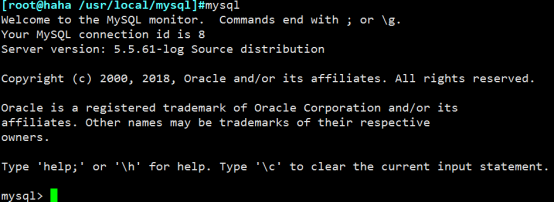
四、编译安装PHP(php-5.5.38)
PHP 通过 PHP-FPM(FastCGI进程管理器)可以很好地与 Nginx 协同工作。PHP-FPM 针对不同规模的网站功能和性能都非常优良,尤其是高并发大型网站。
PHP-FPM是一个实现了Fastcgi的程序,PHP-FPM的管理对象是php-cgi。 后来PHP内核集成了PHP-FPM之后就方便多了,使用--enalbe-fpm这个编译参数即可。
- 编译安装php
网页下载地址:http://am1.php.net/get/php-5.5.38.tar.gz/from/this/mirror
# 配置epel yum源,安装依赖环境
# yum install -y epel-release
两个不能一起安装,因为CentOs6默认的yum源没有 libmcrypt-devel这个包,只能借助epel的yum源,所以先安装epel,再安装(如果之前配置了epel源,就基本不会报错)
[root@test-6 php]# yum -y install gcc libxml2-devel openssl-devel openssl bzip2-devel libmcrypt libmcrypt-devel mcrypt libpng freetype-devel php-mcrypt libjpeg-devel libpng-devel
[root@test-6 php]# tar xf php-5.5.38.tar.gz
[root@test-6 php]# cd php-5.5.38
[root@test-6 php-5.5.38]# ./configure \
--prefix=/usr/local/php \
--with-mysql=/usr/local/mysql \
--enable-fpm \ # 开启fpm
--with-mysqli=/usr/local/mysql/bin/mysql_config \ #(不在同一台就不需要写路径)
--with-config-file-path=/etc \
--with-openssl \
--with-config-file-scan-dir=/etc/php.d \
--with-freetype-dir \
--with-libxml-dir=/usr \
--with-jpeg-dir \
--with-png-dir \
--with-zlib \
--with-bz2 \
--with-mcrypt \
--with-gd \
--with-gettext \
--enable-sockets \
--enable-xml \
--enable-bcmath \
--enable-mbstring
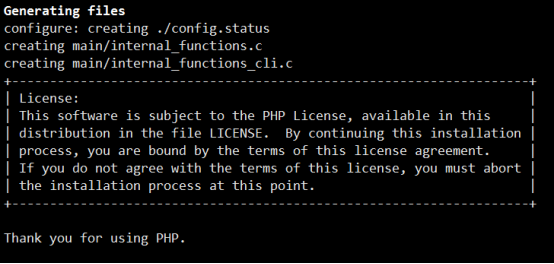
报错:
configure: error: Cannot find MySQL header files under /usr/lib64/mysql.
Note that the MySQL client library is not bundled anymore!
这是由于安装mysql时没有安装mysql头文件,或者是路径指定不正确,php找不到mysql的头文件引起的错误提示
解决方法1:
1. 查看你的系统有没有安装mysql header
find / -name mysql.h
如果有。请指定 --with-mysql=/ 跟你的正常路径。如果没有。请看下一步。
2.redhat安装
rpm -ivh MySQL-devel-4.1.12-1.i386.rpm
3.debian安装
apt-get install libmysqlclient15-dev
4.最后一步php的配置选项添加--with-mysql=/usr即可
解决方法2:
直接--with-mysql就不跟路径
[root@test-6 php-5.5.38]# make && make install
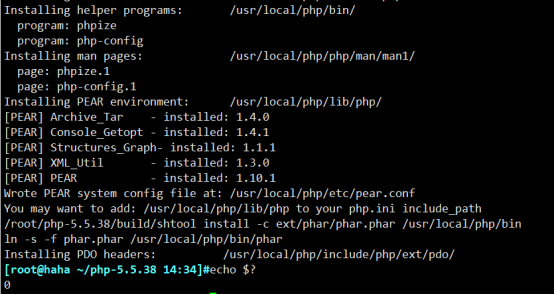
注:make的时候如果报错,那么就在后面加上参数,再试试看。
# make ZEND_EXTRA_LIBS='-liconv'
# make install
[root@test-6 php-5.5.38]# vim /etc/profile.d/php.sh #添加环境变量
export PATH=/usr/local/php/bin:/usr/local/php/sbin:$PATH
[root@VM ~]# ln -sv /usr/local/php/include/ /usr/include/php # 添加php-fpm头文件
`/usr/include/php' -> `/usr/local/php/include/'
[root@test-6 php-5.5.38]# cp php.ini-production /etc/php.ini # 拷贝php.ini配置文件(是在解压包里面拷贝过来的)
优化参数:
expose_php = Off //隐藏PHP版本信息
display_errors //显示php的错误信息
cgi.fix_pathinfo=0 #在 php.ini 中设置,它是用来对设置cgi模式下为php是否提供绝对路径信息或PATH_INFO信息;这会让 PHP 解释器只尝试给定的文件路径,如果没有找到这个文件就停止处理------->配合nginx使用
[root@test-6 php-5.5.38]# cp sapi/fpm/php-fpm.conf /etc/php-fpm.conf # 拷贝php-fpm 配置文件(是在解压包里面拷贝过来的;或者在安装目录里面etc下面)
[root@test-6 php-5.5.38]# vim /etc/php-fpm.conf # 调整php-fpm.conf 配置文件
[global]
pid = /usr/local/php/var/run/php-fpm.pid # 指定pid 文件路径
error_log = /usr/local/php/var/log/php-fpm.log # 指定错误日志log 路径
说明:这里最好写php安装目录下的var目录下面,这样就不用修改启动脚本
修改:配置nginx支持PHP:
user = nginx
group = nginx
注意:默认情况下,nginx安装完成后,仅仅只支持apache,需要修改其属主、属组
去掉这两行的注释,然后确认路劲是否正确;并且把用户与组改为nginx,表示有nginx用户调用
其他优化参数:

下面参数的意思分别为:要求:pm.min_spare_servers <= pm.start_servers <= pm.max_spare_servers
pm = dynamic 如何控制子进程,选项有static和dynamic
pm.max_children:静态方式下开启的php-fpm进程数量
pm.max_requests:php-fpm子进程能处理的最大请求数
pm.start_servers:动态方式下的起始php-fpm进程数量
pm.min_spare_servers:动态方式下的最小php-fpm进程数
pm.max_spare_servers:动态方式下的最大php-fpm进程数量
区别: 如果dm设置为 static,那么其实只有pm.max_children这个参数生效。系统会开启设置数量的php-fpm进程。如果dm设置为 dynamic,那么pm.max_children参数失效,后面3个参数生效,系统会在php-fpm运行开始的时候启动pm.start_servers个php-fpm进程,然后根据系统的需求动态在pm.min_spare_servers和pm.max_spare_servers之间调整php-fpm进程数
https://www.cnblogs.com/pansidong/p/11179618.html
https://segmentfault.com/a/1190000015612563
https://blog.csdn.net/qq_32352565/article/details/79255765
1.通过命令查看服务器上一共开了多少的 php-cgi 进程
ps -fe |grep "php-fpm"|grep "pool"|wc -l
2.查看已经有多少个php-cgi进程用来处理tcp请求
netstat -anp|grep "php-fpm"|grep "tcp"|grep "pool"|wc -l
3.linux+nginx+php环境中,每个php-fpm进程的内存限制
设置方法:编辑php-fpm.conf配置文件
php_admin_value[memory_limit] = 128M(我服务器上的配置文件在/etc/php5/fpm/pool.d/www.conf 这个文件是被包含在php-fpm.conf里的) 后边的数字可以随便更改:32M,64M,128M,256M,512M,这个设置可根据你的服务器内存大小和你的需求来写,修改后要加载一下php-fpm服务
-1 //表示没有内存限制
原文链接:https://blog.csdn.net/leeslee_feng/article/details/46823553
1、phpinfo()函数,
PHP文件中执行phpinfo()函数,提供参数时可查看特定配置
2、 php -i # 查看php參數
与phpinof()相似,是在命令行中执行。加上 | grep configure,可查看编译参数。
3、php -m
查看PHP开启的扩展模块,Linux、Windows中都可以用。
4、php --ini
查看加载的配置文件信息
=====================================================================
listen = 127.0.0.1:9000 #php-fpm的监听端口/也可以写sock文件,这里写什么,必须在nginx里面对应上
pm = static
pm.max_children = 50 #表示fpm模块的最大进程数[静态启动方式设置]
pm.start_servers = 20 #启动时开启的进程数[动态启动方式设置]
pm.min_spare_servers = 5 #最小空闲进程数
pm.max_spare_servers = 20 #最大空闲进程数
listen.owner = nobody
listen.group = nobody
listen.mode = 0660 #设置fpm的权限
listen.allowed_clients = 127.0.0.1 #允许哪些客户端连接fpm;[ln/amp平台不在一台服务器上必须改]
pm.max_requests = 500 #fpm最大支持的请求数量为多少;若设置为0,跟当前的系统资源有关
pid = run/php-fpm.pid
#pid设置,默认在安装目录中的var/run/php-fpm.pid,建议开启
error_log = log/php-fpm.log
#错误日志,默认在安装目录中的var/log/php-fpm.log
log_level = notice
#错误级别. 可用级别为: alert(必须立即处理), error(错误情况), warning(警告情况), notice(一般重要信息), debug(调试信息). 默认: notice.
emergency_restart_threshold = 60
emergency_restart_interval = 60s
#表示在emergency_restart_interval所设值内出现SIGSEGV或者SIGBUS错误的php-cgi进程数如果超过 emergency_restart_threshold个,php-fpm就会优雅重启。这两个选项一般保持默认值。
process_control_timeout = 0
#设置子进程接受主进程复用信号的超时时间. 可用单位: s(秒), m(分), h(小时), 或者 d(天) 默认单位: s(秒). 默认值: 0.
daemonize = yes
#后台执行fpm,默认值为yes,如果为了调试可以改为no。在FPM中,可以使用不同的设置来运行多个进程池。 这些设置可以针对每个进程池单独设置。
listen = 127.0.0.1:9000
#fpm监听端口,即nginx中php处理的地址,一般默认值即可。可用格式为: 'ip:port', 'port', '/path/to/unix/socket'. 每个进程池都需要设置.
listen.backlog = -1
#backlog数,-1表示无限制,由操作系统决定,此行注释掉就行。backlog含义参考:http://www.3gyou.cc/?p=41
listen.allowed_clients = 127.0.0.1
#允许访问FastCGI进程的IP,设置any为不限制IP,如果要设置其他主机的nginx也能访问这台FPM进程,listen处要设置成本地可被访问的IP。默认值是any。每个地址是用逗号分隔. 如果没有设置或者为空,则允许任何服务器请求连接
listen.owner = www
listen.group = www
listen.mode = 0666
#unix socket设置选项,如果使用tcp方式访问,这里注释即可。
user = www
group = www
#启动进程的帐户和组
pm = dynamic #对于专用服务器,pm可以设置为static。
#如何控制子进程,选项有static和dynamic。如果选择static,则由pm.max_children指定固定的子进程数。如果选择dynamic,则由下开参数决定:
pm.max_children #,子进程最大数
pm.start_servers #,启动时的进程数
pm.min_spare_servers #,保证空闲进程数最小值,如果空闲进程小于此值,则创建新的子进程
pm.max_spare_servers #,保证空闲进程数最大值,如果空闲进程大于此值,此进行清理
pm.max_requests = 1000
#设置每个子进程重生之前服务的请求数. 对于可能存在内存泄漏的第三方模块来说是非常有用的. 如果设置为 '0' 则一直接受请求. 等同于 PHP_FCGI_MAX_REQUESTS 环境变量. 默认值: 0.
pm.status_path = /status
#FPM状态页面的网址. 如果没有设置, 则无法访问状态页面. 默认值: none. munin监控会使用到
ping.path = /ping
#FPM监控页面的ping网址. 如果没有设置, 则无法访问ping页面. 该页面用于外部检测FPM是否存活并且可以响应请求. 请注意必须以斜线开头 (/)。
ping.response = pong
#用于定义ping请求的返回相应. 返回为 HTTP 200 的 text/plain 格式文本. 默认值: pong.
request_terminate_timeout = 0
#设置单个请求的超时中止时间. 该选项可能会对php.ini设置中的'max_execution_time'因为某些特殊原因没有中止运行的脚本有用. 设置为 '0' 表示 'Off'.当经常出现502错误时可以尝试更改此选项。
request_slowlog_timeout = 10s
#当一个请求该设置的超时时间后,就会将对应的PHP调用堆栈信息完整写入到慢日志中. 设置为 '0' 表示 'Off'
slowlog = log/$pool.log.slow
#慢请求的记录日志,配合request_slowlog_timeout使用
rlimit_files = 1024
#设置文件打开描述符的rlimit限制. 默认值: 系统定义值默认可打开句柄是1024,可使用 ulimit -n查看,ulimit -n 2048修改。
rlimit_core = 0
#设置核心rlimit最大限制值. 可用值: 'unlimited' 、0或者正整数. 默认值: 系统定义值.
chroot =
#启动时的Chroot目录. 所定义的目录需要是绝对路径. 如果没有设置, 则chroot不被使用.
chdir =
#设置启动目录,启动时会自动Chdir到该目录. 所定义的目录需要是绝对路径. 默认值: 当前目录,或者/目录(chroot时)
catch_workers_output = yes
#重定向运行过程中的stdout和stderr到主要的错误日志文件中. 如果没有设置, stdout 和 stderr 将会根据FastCGI的规则被重定向到 /dev/null . 默认值: 空.
[root@test-6 php-5.5.38]# cp sapi/fpm/init.d.php-fpm /etc/init.d/php-fpm # 拷贝php-fpm 启动脚本文件
sbin]# ./php-fpm -t #检查配置文件是否正确
[29-Jan-2021 22:41:22] NOTICE: configuration file /usr/local/php/etc/php-fpm.conf test is successful
[root@test-6 php-5.5.38] #chmod --reference=/etc/init.d/iptables /etc/init.d/php-fpm # 修改启动脚本权限
[root@test-6 php-5.5.38]# vim /etc/init.d/php-fpm # 修改php-fpm启动脚本文件->注意:这里必须填正确,安装你安装的路径填写
#! /bin/sh
prefix=/usr/local/php #确认安装位置是否正确
exec_prefix=${prefix}
php_fpm_BIN=${exec_prefix}/sbin/php-fpm #php-fpm二进制文件位置
php_fpm_CONF=${exec_prefix}/etc/php-fpm.conf # 指定php-fpm conf 路径
php_fpm_PID=${exec_prefix}/var/run/php-fpm.pid # 指定php-fpm.pid 路径
[root@test-6 php-5.5.38]# chkconfig --add php-fpm
[root@test-6 php-5.5.38]# chkconfig php-fpm on
[root@test-6 php-5.5.38]# service php-fpm start
Starting php-fpm done
[root@test-6 php-5.5.38]# ss -tunl |grep 9000
Netid State Recv-Q Send-Q Local Address:Port Peer Address:Port
tcp LISTEN 0 128 127.0.0.1:9000 *:*
- 配置nginx支持php
[root@test-6 html]# vim /etc/nginx/nginx.conf
server {
listen 80;
server_name localhost;
#charset koi8-r;
#access_log logs/host.access.log main;
location / {
root html; #如果找不到页面,就改成绝对路径
index index.html index.htm index.php; # 该项添加index.php,如果添加到第一的位置,则直接访问IP就是访问的php页面。
}
location ~ \.php$ { #取消该段内容反向解析的注释
root /usr/local/nginx/html; #如果解析不出来,这个地方要改下下,改成绝对路径
fastcgi_pass 127.0.0.1:9000; # fastcgi监听端口
fastcgi_index index.php; #和访问文件名相同
fastcgi_param SCRIPT_FILENAME $document_root$fastcgi_script_name; # 把$Scripts 调整为$document_root # fastcgi.conf文件位置
include fastcgi_params;
}
$document_root 代表当前请求在root指令中指定的值:
上面配置中的$document_root就是针对/usr/local/nginx/html目录下的php文件进行解析
或者写成:
location ~ \.php$ {
root /usr/local/nginx/html;#其实与FastCGI无关
fastcgi_pass 127.0.0.1:9000;#这里是套接字连接方式不用更改。如果是Unix文件描述符连接方式就需要更改,例如:fastcgi_pass unix:/var/run/php/php7.0-fpm.sock;
fastcgi_index index.php;#制定了fastcgi的主页是index.php
# fastcgi_param SCRIPT_FILENAME /scripts$fastcgi_script_name;注释该句
# include fastcgi_params;注释该句
include fastcgi.conf; #(添加一句)
}
参数解释:Nginx官方包自带配置分析
注:Nginx官方包来自:http://nginx.org/en/linux_packages.html#stable 我们先用Nginx官方打的包来举例,如果懒得安装可以直接在github上看:https://github.com/nginx/nginx/tree/master/conf。 可以看到,在Nginx主配置文件nginx.conf(https://github.com/nginx/nginx/blob/master/conf/nginx.conf),Server段中与PHP交互相关部分在:
# proxy the PHP scripts to Apache listening on 127.0.0.1:80
#
#location ~ \.php$ {
# proxy_pass http://127.0.0.1;
#}
# pass the PHP scripts to FastCGI server listening on 127.0.0.1:9000
#
#location ~ \.php$ {
# root html;
# fastcgi_pass 127.0.0.1:9000;
# fastcgi_index index.php;
# fastcgi_param SCRIPT_FILENAME /scripts$fastcgi_script_name;
# include fastcgi_params;
#}
通过注释可以看到,上面一段是Nginx反代Apache+PHP的时候用的,下面这段使我们真正需要分析的。
第一句location ~ \.php$很简单,~表示大小写区分的正则匹配,如果对Nginx匹配规则不清楚的推荐阅读Nginx官方文档和这篇文章。后面的.php$匹配了所有结尾是.php的URI。
这里其实有个需要注意的地方。我们在使用很多PHP框架或自己写PHP的时候,经常会使用index.php做路由,便会出现类似于index.php/foo/bar这种URI,显然,这样的URI是匹配不到.php$的,我们可以将匹配规则改为:
location ~ .*\.php(\/.*)*$
第二行root html;其实与FastCGI无关,如果往上翻翻就可以发现他并没有把root写在server段,而是写在了每个location段,这里只是指定下根目录位置。在Debian的默认配置中,root参数是直接写在server段的,所以就不需要在这里再次指定root参数了。
第三行fastcgi_pass便是制定Nginx去哪找到FastCGI服务器的Master进程。套接字连接方式不用修改。Debian下安装好php-fpm后默认就是Unix文件描述符连接方式。这里写为
fastcgi_pass unix:/var/run/php/php7.0-fpm.sock; # Debian 9 PHP 7.0
或
fastcgi_pass unix:/var/run/php5-fpm.sock; # Debian 7/8 PHP 5.x
从PHP7.*开始,文件描述符会放在/var/run/php下,并会显示出小数点后一位版本号,意味着Debian 10如果带的是PHP7.3版本(99%可能性),就可以写为
fastcgi_pass unix:/var/run/php/php7.3-fpm.sock;
第四行fastcgi_index制定了fastcgi的主页是index.php,无须解释。
第五行就很有点意思了。我们连带第六行一起说。第六行引入了一个新文件fastcgi_params,我们将fastcgi_params的内容也贴在下面:
fastcgi_param QUERY_STRING $query_string;
fastcgi_param REQUEST_METHOD $request_method;
fastcgi_param CONTENT_TYPE $content_type;
fastcgi_param CONTENT_LENGTH $content_length;
fastcgi_param SCRIPT_NAME $fastcgi_script_name;
fastcgi_param REQUEST_URI $request_uri;
fastcgi_param DOCUMENT_URI $document_uri;
fastcgi_param DOCUMENT_ROOT $document_root;
fastcgi_param SERVER_PROTOCOL $server_protocol;
fastcgi_param REQUEST_SCHEME $scheme;
fastcgi_param HTTPS $https if_not_empty;
fastcgi_param GATEWAY_INTERFACE CGI/1.1;
fastcgi_param SERVER_SOFTWARE nginx/$nginx_version;
fastcgi_param REMOTE_ADDR $remote_addr;
fastcgi_param REMOTE_PORT $remote_port;
fastcgi_param SERVER_ADDR $server_addr;
fastcgi_param SERVER_PORT $server_port;
fastcgi_param SERVER_NAME $server_name;
# PHP only, required if PHP was built with --enable-force-cgi-redirect
fastcgi_param REDIRECT_STATUS 200;
可以看到,第六行引入的这个文件和第五行一样都是以fastcgi_param打头。fastcgi_param用于指定Nginx将文件传入FastCGI Server时的各种参数使用的。如第五行
fastcgi_param SCRIPT_FILENAME /scripts$fastcgi_script_name;
说明了要传入的文件是/scripts/下的具体php文件名,这就使得FastCGI Server会去/scripts目录下找这个php文件。如果你的php文件其实不在这个目录下(比如网站根目录下),FastCGI Server其实根本找不到。所以我们必须把/scripts改成和root参数一样的实际网站根目录。一段时间后Nginx官方也发现这个参数太不方便了,提供了一个$document_root参数指向当前网站根目录,所以我们可以改成:
fastcgi_param SCRIPT_FILENAME $document_root$fastcgi_script_name;
Nginx顺便还提供了一个包括了这个参数的新的fastcgi_params文件重命名为fastcgi.conf:https://github.com/nginx/nginx/blob/master/conf/fastcgi.conf。但由于兼容性原因和历史包袱,保留了nginx.conf的写法和fastcgi_params文件,实际上,我们大可以将第五六行
# fastcgi_param SCRIPT_FILENAME /scripts$fastcgi_script_name;
# include fastcgi_params;
# 直接改成
include fastcgi.conf;
[root@test-6 html]# service nginx restart
Stopping nginx: [ OK ]
Starting nginx: [ OK ]
[root@test-6 html]# vim /usr/local/nginx/html/index.php # php 测试
<?php
phpinfo ();
?>
[root@test-6 html]# curl -I http://localhost/index.php # 验证php启动
HTTP/1.1 200 OK
Server: nginx/1.8.1
或者网页访问:
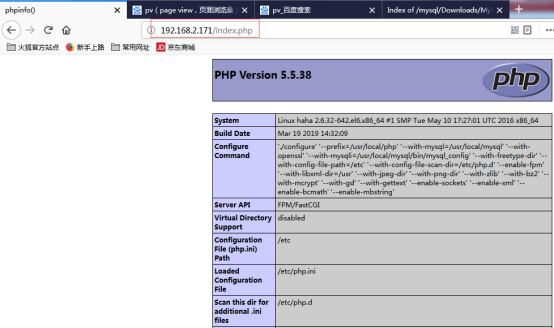
- 验证php功能与nginx ,php与mysql 连接
参考:https://blog.csdn.net/zhoucheng05_13/article/details/75082722
[root@VM ~]# vim /usr/local/nginx/html/php-mysql.php # 测试nginx 与 php 连接状态脚本,php与mysql 连接
<?php
$link = mysql_connect('localhost','root','666666');
if ($link)
echo "sucessful.";
else
echo "failure.";
mysql_close();
phpinfo();
?>
进入mysql,对root用户,在localhost主机上进行授权
mysql> GRANT ALL PRIVILEGES ON *.* TO 'root'@'localhost' identified by '666666';
ps:授权的时候,授权的主机、授权的用户必须与测试网页里面写的主机与用户的相同,才能进行连接到mysql,否则无法连接至mysql
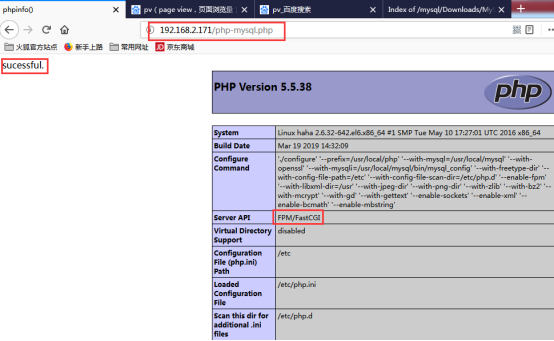
如果无法连接,可以打开php错误信息,然后一步一步的排查:
修改配置文件:
- /etc/php/7.0/fpm/php.ini
设置display_errors = On
- /etc/php/7.0/fpm/php-fpm.conf (或者:/usr/local/php/etc/php-fpm.d/www.conf)
设置php_flag[display_errors] = on
总结:如下几种方法也可以屏蔽错误回显信息:
1.php.ini的display_errors在php.ini文件中找到display_errors设置项,如果前面有分号,需要删去分号,并将值改为off
2.php.ini的error_reporting这个是修改错误级别显示,如果将级别设为最高等级的,则什么错误都不会显示在php.ini中找到error_reporting,去掉前面的分号(如果有),并将值改为0
3.使用ini_set函数配置此方法同方法1、2,只是在代码里面写,在无法修改php.ini的时候使用string ini_set ( string $varname , string $newvalue )ini_set('display_errors', '0');ini_set('error_reporting','0');
4.使用error_reporting函数int error_reporting ([ int $level ] )error_reporting(0); #关闭所有错误报告
5.使用@屏蔽单条语句的错误回显在需要屏蔽错误回显的语句前添加@符号
然后:
service nginx reload
就好了
php7的连接语法:
[root@LNMP html]# vim index.php
<?php
$link = mysqli_connect('localhost','root','666666');
if ($link)
echo "sucessful.";
else
echo "failure.";
phpinfo();
?>

五、安装php加速器xcache
- 安装xcache
下载地址:http://xcache.lighttpd.net/pub/Releases/3.2.0/xcache-3.2.0.tar.gz
[root@test-6 php]# tar xf xcache-3.2.0.tar.gz
[root@test-6 php]# cd xcache-3.2.0
[root@test-6 xcache-3.2.0]# phpize # 编译php模块
Configuring for:
PHP Api Version: 20121113
Zend Module Api No: 20121212
Zend Extension Api No: 220121212
[root@test-6 xcache-3.2.0]# ./configure --enable-xcache --with-php-config=/usr/local/php/bin/php-config # 编译安装(关联php-config)

[root@test-6 xcache-3.2.0]# make && make install # 安装,记录生成的文件路径
Installing shared extensions: /usr/local/php/lib/php/extensions/no-debug-non-zts-20121212/

[root@test-6 xcache-3.2.0]# mkdir -pv /etc/php.d
[root@test-6 xcache-3.2.0]# cp xcache.ini /etc/php.d/xcache.ini
[root@test-6 xcache-3.2.0]# vim /etc/php.d/xcache.ini
;; this is an example, it won't work unless properly configured into php.ini
[xcache-common]
;; non-Windows example:
extension = /usr/local/php/lib/php/extensions/no-debug-non-zts-20121212/xcache.so #修改该配置,变为绝对路径
[root@test-6 xcache-3.2.0]# service php-fpm restart # 重启php-fpm 相关服务
Gracefully shutting down php-fpm . done
Starting php-fpm done
- 验证xcache 安装
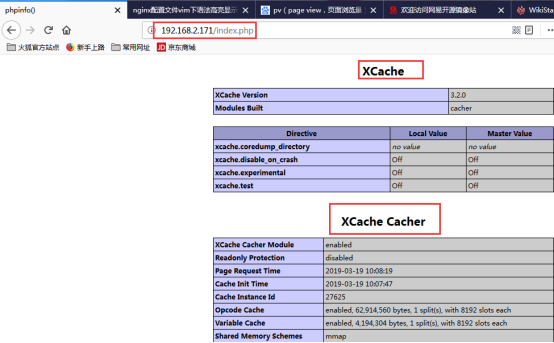
六、安装phpMyAdmin-4.8.2 ,管理mysql
- 安装phpMyAdmin-4.8.2 ,支持php5.5- php 7.2 ,mysql-5.5 以上
下载地址:https://files.phpmyadmin.net/phpMyAdmin/4.8.2/phpMyAdmin-4.8.2-all-languages.tar.xz
[root@test-6 mysql]# wget https://files.phpmyadmin.net/phpMyAdmin/4.8.2/phpMyAdmin-4.8.2-all-languages.tar.xz
[root@test-6 mysql]# tar xf phpMyAdmin-4.8.2-all-languages.tar.xz
[root@test-6 mysql]# cp phpMyAdmin-4.8.2-all-languages /usr/local/nginx/html/phpadm
-
phpMyadmin 登录http://192.168.2.171/phpadm 验证
-
用户名
root -
密码为
数据库root密码
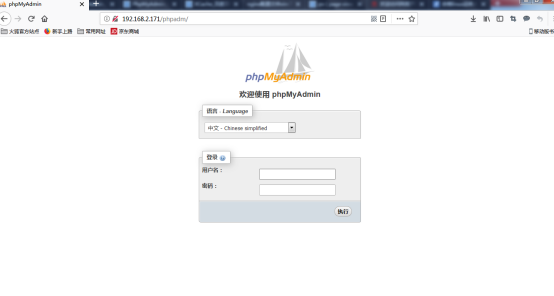
- 错误故障解决

1) Failed to set session cookie. Maybe you are using HTTP instead of HTTPS to access phpMyAdmin.
Failed to set session cookie. Maybe you are using HTTP instead of HTTPS to access phpMyAdmin.
@设置会话cookie失败。也许您正在使用HTTP而不是HTTPS访问phpMyAdmin。
用https登陆
2)配置文件现在需要一个短密码:
解决办法:设定 config.default.php 文件的108行$cfg['blowfish_secret']参数,参数字符串长度必须在32位以上。
[root@VM pmyadmin]# vim libraries/config.default.php # 在phpMyAdmin目录下libraries文件下的config.default.php
$cfg['blowfish_secret'] = 'asdfghjklzxcvbnm!@#$%^&*';

3)$cfg['TempDir'] (./tmp/) 读取失败且不能建立缓存, phpMyAdmin运行速度将受影响.
解决办法:手动在phpmyadmin的根目录建立tmp文件,并赋予777权限
[root@VM pmyadmin]# mkdir -m 777 tmp

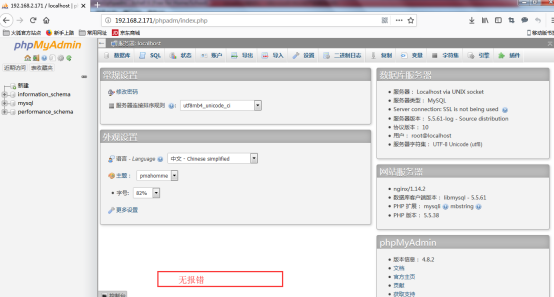
分布式的架构

如果fastcgi安装在其它主机上实现有是分布是的架构,如上图,对于php页面的处理需要修改,一共需要修改几个地方:
(1)修改nginx.conf文件如下:
location ~ \.php$ {
root html;
fastcgi_pass 192.168.129.22:9000;
fastcgi_index index.php;
fastcgi_param SCRIPT_FILENAME /opt/www/$fastcgi_script_name;
include fcgi.conf;
}
两处说明:一个是访问nginx,nginx把请求转发到fastcgi处理,但是php页面又是在fastcgi那台机器上的/opt/www目录中,所以需要修改以上两个地方才能实现php页面的解析。 (2)修改/usr/local/php/etc/php-fpm.conf文件 注:在安装fastcgi主机上:
<value name="listen_address">192.168.129.22:9000</value>
<value name="allowed_clients">192.168.129.21</value>
说明: 第一处监听本机的9000端口,默认是127.0.0.1,由于是分布式应用,需要修改。 第二处只允许nginx发来的请求给予解析,也需要修改
服务器分布
ip 设备
192.168.137.70 NGINX
192.168.137.60 PHP7.2
192.168.137.50 MYSQL5.7
1.安装mysql5.7(192.168.137.50)
1.1下载mysql
cd /usr/src/
wget https://downloads.mysql.com/archives/get/file/mysql-5.7.22-linux-glibc2.12-x86_64.tar.gz
1.2创建mysql的用户和组
groupadd -r -g 306 mysql
useradd -M -s /sbin/nologin -g 306 -u 306 mysql
1.3解压mysql包
tar xf mysql-5.7.22-linux-glibc2.12-x86_64.tar.gz -C /usr/local/
cd /usr/local/
ln -sv mysql-5.7.22-linux-glibc2.12-x86_64/ mysql #创建软连接,方便后续升级
"mysql" -> "mysql-5.7.23-linux-glibc2.12-x86_64/"
ll | grep mysql
lrwxrwxrwx 1 root root 47 Nov 8 10:37 mysql -> /usr/local/mysql-5.7.22-linux-glibc2.12-x86_64/
drwxr-xr-x 9 root root 129 Nov 8 10:34 mysql-5.7.22-linux-glibc2.12-x86_64
1.4修改解压位置mysql文件的属主和组
chown -R mysql.mysql /usr/local/mysql
ll|grep mysql
lrwxrwxrwx 1 mysql mysql 36 Nov 8 10:44 mysql -> mysql-5.7.22-linux-glibc2.12-x86_64/
drwxr-xr-x 9 root root 129 Nov 8 10:34 mysql-5.7.22-linux-glibc2.12-x86_64
1.5创建环境变量
echo 'export PATH=/usr/local/mysql/bin:$PATH' > /etc/profile.d/mysql.sh
. /etc/profile.d/mysql.sh
which mysql
/usr/local/mysql/bin/mysql
1.6建立数据存放目录并初始化
mkdir /opt/data
chown -R mysql.mysql /opt/data/
ll /opt/data/ -d
drwxr-xr-x 2 mysql mysql 6 Nov 8 10:50 /opt/data/
/usr/local/mysql/bin/mysqld --initialize --user=mysql --datadir=/opt/data/
2019-11-08T02:54:09.651769Z 0 [Warning] TIMESTAMP with implicit DEFAULT value is deprecated. Please use --explicit_defaults_for_timestamp server option (see documentation for more details).
2019-11-08T02:54:10.186527Z 0 [Warning] InnoDB: New log files created, LSN=45790
2019-11-08T02:54:10.226450Z 0 [Warning] InnoDB: Creating foreign key constraint system tables.
2019-11-08T02:54:10.288765Z 0 [Warning] No existing UUID has been found, so we assume that this is the first time that this server has been started. Generating a new UUID: 09d4c4ab-01d3-11ea-9add-000c29944549.
2019-11-08T02:54:10.289382Z 0 [Warning] Gtid table is not ready to be used. Table 'mysql.gtid_executed' cannot be opened.
2019-11-08T02:54:10.289764Z 1 [Note] A temporary password is generated for root@localhost: -Eq+Zfy;d84Z #最后一行为随机密码
1.7配置mysql
ln -sv /usr/local/mysql/include/ /usr/local/include/mysql
"/usr/local/include/mysql" -> "/usr/local/mysql/include/"
ll !$
lrwxrwxrwx 1 root root 25 Nov 8 10:58 /usr/local/include/mysql -> /usr/local/mysql/include/
echo '/usr/local/mysql/lib' > /etc/ld.so.conf.d/mysql.conf
ldconfig -v
1.8生成配置文件
cat > /etc/my.cnf <<EOF
[mysqld]
basedir = /usr/local/mysql
datadir = /opt/data
socket = /tmp/mysql.sock
port = 3306
pid-file = /opt/data/mysql.pid
user = mysql
skip-name-resolve
EOF
# cat /etc/my.cnf
[mysqld]
basedir = /usr/local/mysql
datadir = /opt/data
socket = /tmp/mysql.sock
port = 3306
pid-file = /opt/data/mysql.pid
user = mysql
skip-name-resolve
配置服务启动脚本
cp -a /usr/local/mysql/support-files/mysql.server /etc/init.d/mysqld
# vim /etc/init.d/mysqld #修改这两行
basedir=/usr/local/mysql
datadir=/opt/data
1.10启动服务mysql
service mysqld start
Starting MySQL.Logging to '/opt/data/localhost.localdomain.err'.
SUCCESS!
1.11修改密码
mysql -uroot -p
Enter password: #之前初始化生成的密码
mysql> show databases;
ERROR 1820 (HY000): You must reset your password using ALTER USER statement before executing this statement.
mysql> use mysql;
ERROR 1820 (HY000): You must reset your password using ALTER USER statement before executing this statement. #这里不管操作什么都是不行的,必须修改root密码
mysql> set password = password('666666');
Query OK, 0 rows affected, 1 warning (0.00 sec)
mysql> flush privileges; #刷新数据库
2.安装php-7.2.8 (192.168.137.60)
2.1创建nginx用户
groupadd -r -g 955 nginx
useradd -M -s /sbin/nologin -g 955 -u 955 nginx
id nginx
uid=955(nginx) gid=955(nginx) 组=955(nginx) #确保php和nginx的nginx用户的uid,gid,组id一致
2.2安装php依赖包
yum -y install epel-release gcc gcc-c++
yum -y install libxml2 libxml2-devel openssl openssl-devel bzip2 bzip2-devel libcurl libcurl-devel libjpeg libjpeg-devel libpng libpng-devel freetype freetype-devel gmp gmp-devel libmcrypt libmcrypt-devel readline readline-devel libxslt libxslt-devel mhash mhash-devel
2.3下载并解压安装php
cd /usr/src/
wget http://cn.php.net/distributions/php-7.2.8.tar.xz
tar xvf php-7.2.8.tar.xz
cd php-7.2.8/
./configure --prefix=/usr/local/php7 \
--with-config-file-path=/usr/local/php7/etc \
--with-config-file-scan-dir=/usr/local/php7/etc/php.d \
--with-mysql=mysqlnd \
--with-pdo-mysql=mysqlnd \
--with-mysqli=mysqlnd \
--enable-mysqlnd \
--with-openssl \
--enable-fpm \
--enable-sockets \
--enable-sysvshm \
--enable-mbstring \
--with-freetype-dir \
--with-jpeg-dir \
--with-png-dir \
--with-zlib \
--with-libxml-dir=/usr \
--enable-xml \
--with-mhash \
--with-mcrypt=/usr \
--with-bz2 \
--enable-maintainer-zts \
&& make && make install
-------------------------------------------------------------------
./configure --prefix=/usr/local/php7 \
--with-config-file-path=/usr/local/php7/etc/ \
--with-config-file-scan-dir=/usr/local/php7/etc/conf.d \
--with-mysqli=mysqlnd \
--with-pdo-mysql=mysqlnd \
--enable-mysqlnd \
--with-mysql-sock=/tmp/mysql.sock \
--with-fpm-user=nginx \
--with-fpm-group=nginx \
--with-iconv-dir \
--with-freetype-dir \
--with-jpeg-dir \
--with-png-dir \
--with-zlib \
--with-bz2 \
--with-libxml-dir \
--with-curl \
--with-gd \
--with-openssl \
--with-mhash \
--with-xmlrpc \
--with-pdo-mysql \
--with-libmbfl \
--with-onig \
--with-pear \
--enable-xml \
--enable-bcmath \
--enable-shmop \
--enable-sysvsem \
--enable-inline-optimization \
--enable-mbregex \
--enable-fpm \
--enable-mbstring \
--enable-pcntl \
--enable-sockets \
--enable-zip \
--enable-soap \
--enable-opcache \
--enable-pdo \
--enable-mysqlnd-compression-support \
--enable-maintainer-zts \
--enable-session \
--enable-ftp \
--enable-gd-native-ttf \
--with-mcrypt \
--with-xsl \
--enable-static=PKGS \
--with-gettext \
--enable-trans-sid
2.4配置环境变量
echo 'export PATH=/usr/local/php7/bin:$PATH' > /etc/profile.d/php7.sh
source /etc/profile.d/php7.sh
which php
2.5配置php-fpm
cp php.ini-production /usr/local/php7/etc/php.ini
cp sapi/fpm/init.d.php-fpm /etc/init.d/php-fpm
chmod +x /etc/rc.d/init.d/php-fpm
cd /usr/local/php7/etc/
ll
total 84
-rw-r--r-- 1 root root 1240 Nov 8 14:57 pear.conf
-rw-r--r-- 1 root root 4468 Nov 8 14:57 php-fpm.conf.default
drwxr-xr-x 2 root root 30 Nov 8 14:57 php-fpm.d
-rw-r--r-- 1 root root 70569 Nov 8 15:06 php.ini
cp php-fpm.conf.default php-fpm.conf
# tail !$
tailf php-fpm.conf
; used in logs and stats. There is no limitation on the number of pools which
; FPM can handle. Your system will tell you anyway :)
; Include one or more files. If glob(3) exists, it is used to include a bunch of
; files from a glob(3) pattern. This directive can be used everywhere in the
; file.
; Relative path can also be used. They will be prefixed by:
; - the global prefix if it's been set (-p argument)
; - /usr/local/php7 otherwise
include=/usr/local/php7/etc/php-fpm.d/*.conf
cd php-fpm.d/
cp www.conf.default www.conf
2.6修改php-fpm配置文件
cd ..
vim php-fpm.conf #如果该配置文件不存在这些参数,那么就在php-fpm.d/www.conf
user = nginx
group = nginx
listen = 192.168.137.60:9000 #本机ip
pm.max_children = 50
pm.start_servers = 5
pm.min_spare_servers = 2
pm.max_spare_servers = 8
sbin]# ./php-fpm -t #检查配置文件是否正确
[29-Jan-2021 22:41:22] NOTICE: configuration file /usr/local/php/etc/php-fpm.conf test is successful
2.7启动php-fpm
service php-fpm start
Starting php-fpm done
# netstat -nutlp|grep 9000
tcp 0 0 192.168.137.60:9000 0.0.0.0:* LISTEN 15756/php-fpm: mast
3.nginx安装与配置(192.168.137.70)
3.1创建nginx用户 确保php服务器上创建的nginx用户的uid,gid,组id一致
groupadd -r -g 955 nginx
useradd -M -s /sbin/nologin -g 955 -u 955 nginx
id nginx
uid=955(nginx) gid=955(nginx) groups=955(nginx)
3.2安装nginx依赖环境
yum -y install pcre-devel openssl openssl-devel gd-devel gcc gcc-c++
yum -y groupinstall 'Development Tools'
3.3建立nginx日志存放目录 --这里看情况,日志和pid文件放的位置有你觉得
mkdir -p /var/log/nginx
chown -R nginx.nginx /var/log/nginx/
ll /var/log/nginx/ -d
drwxr-xr-x 2 nginx nginx 6 Nov 8 15:38 /var/log/nginx/
3.4下载并安装nginx
cd /usr/src/
wget http://nginx.org/download/nginx-1.12.0.tar.gz
tar -xvf nginx-1.12.0.tar.gz
cd nginx-1.12.0/
./configure \
--prefix=/usr/local/nginx \
--user=nginx \
--group=nginx \
--with-debug \
--with-http_ssl_module \
--with-http_realip_module \
--with-http_image_filter_module \
--with-http_gunzip_module \
--with-http_gzip_static_module \
--with-http_stub_status_module \
--http-log-path=/var/log/nginx/access.log \
--error-log-path=/var/log/nginx/error.log \
--with-pcre \
--with-stream
Configuration summary
+ using system PCRE library
+ using system OpenSSL library
+ using system zlib library
nginx path prefix: "/usr/local/nginx"
nginx binary file: "/usr/local/nginx/sbin/nginx"
nginx modules path: "/usr/local/nginx/modules"
nginx configuration prefix: "/usr/local/nginx/conf"
nginx configuration file: "/usr/local/nginx/conf/nginx.conf"
nginx pid file: "/usr/local/nginx/logs/nginx.pid"
nginx error log file: "/var/log/nginx/error.log"
nginx http access log file: "/var/log/nginx/access.log"
nginx http client request body temporary files: "client_body_temp"
nginx http proxy temporary files: "proxy_temp"
nginx http fastcgi temporary files: "fastcgi_temp"
nginx http uwsgi temporary files: "uwsgi_temp"
nginx http scgi temporary files: "scgi_temp"
make && make install
3.5配置nginx的环境变量
echo 'export PATH=/usr/local/nginx/sbin:$PATH' > /etc/profile.d/nginx.sh
. /etc/profile.d/nginx.sh
which nginx
nginx #启动nginx
# ss -antl|grep :80
LISTEN 0 128 *:80 *:*
3.6nginx的控制方式
# nginx -h
-t 检查配置文件语法
-v 输出nginx版本
-c 制定配置文件路径
-s 发送服务控制信号ํ{stop|quit|reopen|reload}
3.7配置nginx
cd /usr/local/nginx/conf/
vim nginx.conf
#access_log logs/host.access.log main;
location / {
root html;
index index.php index.html index.htm; #在这里加上index.php
······
location ~ \.php$ {
root html;
fastcgi_pass 192.168.137.60:9000; #php的ip地址
fastcgi_index index.php;
fastcgi_param SCRIPT_FILENAME $document_root$fastcgi_script_name;
include fastcgi_params; 去掉这几行前面的#号
}
注意:如果php和nginx不在一台。那么php代码就要放在php服务器上面。那么nginx处理静态页面的代码就要放在nginx服务器上面。 php服务器上面的代码路径在nginx配置文件里面指定的,且必须路径要一样,否则找不到文件

这个是把php代码目录写死的,放在
/data/nginx/html/php/下面
4.查看效果
这里必须在php、nginx创建相同的页面才能加载,因为nginx、php不在一台服务器上。因此这里就可以部署文件共享服务器了
4.1 创建html(192.168.137.60)(为什么要创建/usr/local/nginx/html/,因为nginx配置的是$document_root那么在php那台服务器上面就需要创建与nginx的root路径一样的代码目录)
mkdir -p /usr/local/nginx/html/
chown -R nginx.nginx /usr/local/nginx/html/
cd /usr/local/nginx/html/
vim index.php
<?php
$link = mysqli_connect('192.168.137.50','root','666666');
if ($link)
echo "sucessful.";
else
echo "failure.";
phpinfo();
?>
4.2 创建html(192.168.137.70)
cd /usr/local/nginx/html
vim index.php
<?php
$link = mysqli_connect('192.168.137.50','root','666666');
if ($link)
echo "sucessful.";
else
echo "failure.";
phpinfo();
?>
说明:192.168.137.50为数据库的IP地址
4.3重载nginx的配置文件和重启php服务
[root@localhost ~]# nginx -s reload
[root@localhost ~]# service php-fpm restart
4.4登录网页
192.168.137.70

5.mysql配置+wordpress
5.1数据库服务器上创建wordpress数据库及授权帐户(192.168.137.50)
mysql -uroot -p
mysql> create database wordpress;
Query OK, 1 row affected (0.00 sec)
mysql> grant all on wordpress.* to root@'%' identified by '666666';
Query OK, 0 rows affected, 1 warning (0.00 sec)
mysql> flush privileges ;
Query OK, 0 rows affected (0.00 sec)
5.2下载wordpress并解压到nginx的服务器
cd /usr/src/
wget https://wordpress.org/latest.tar.gz
tar zxf latest.tar.gz
cp -rf wordpress /usr/local/nginx/html/
5.3下载wordpress并解压到PHP的服务器
cd /usr/src/
wget https://wordpress.org/latest.tar.gz
tar zxf latest.tar.gz
cp -rf wordpress /usr/local/nginx/html/
5.4修改wordpress
cd /usr/local/nginx/html/wordpress/
cp wp-config-sample.php wp-config.php
vim wp-config.php
#更改的内容
// ** MySQL settings - You can get this info from your web host ** //
/** The name of the database for WordPress */
define( 'DB_NAME', 'wordpress' );
/** MySQL database username */
define( 'DB_USER', 'root' );
/** MySQL database password */
define( 'DB_PASSWORD', '666666' );
/** MySQL hostname */
define( 'DB_HOST', '192.168.137.50' );
/** Database Charset to use in creating database tables. */
define( 'DB_CHARSET', 'utf8' );
/** The Database Collate type. Don't change this if in doubt. */
define( 'DB_COLLATE', '' );
文件末尾添加:加不加都无所谓
require_once(ABSPATH . 'wp-settings.php');
define("FS_METHOD","direct");
define("FS_CHMOD_DIR", 0777);
define("FS_CHMOD_FILE", 0777);
5.4测试访问
http://192.168.137.70/wordpress
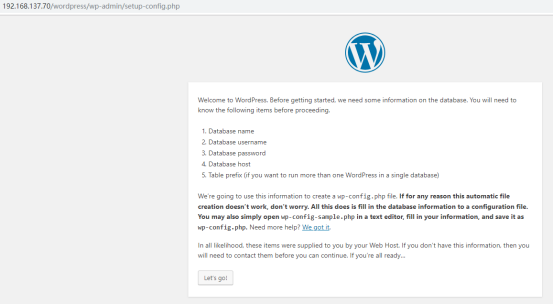
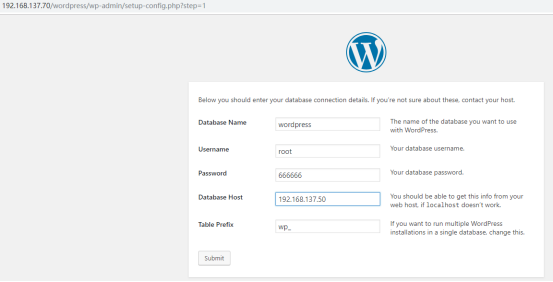

重新加载:
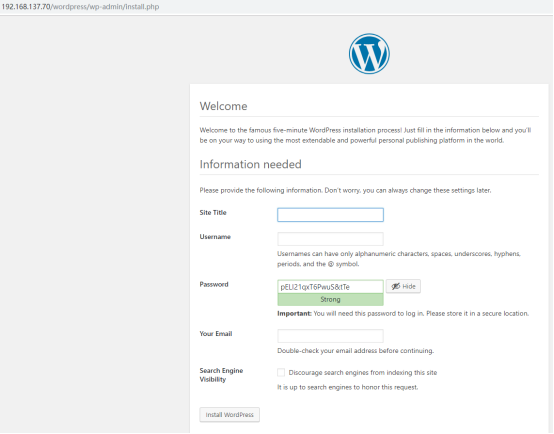

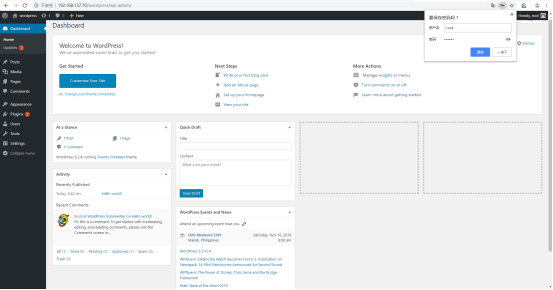
免责声明: 本文部分内容转自网络文章,转载此文章仅为个人收藏,分享知识,如有侵权,请联系博主进行删除。